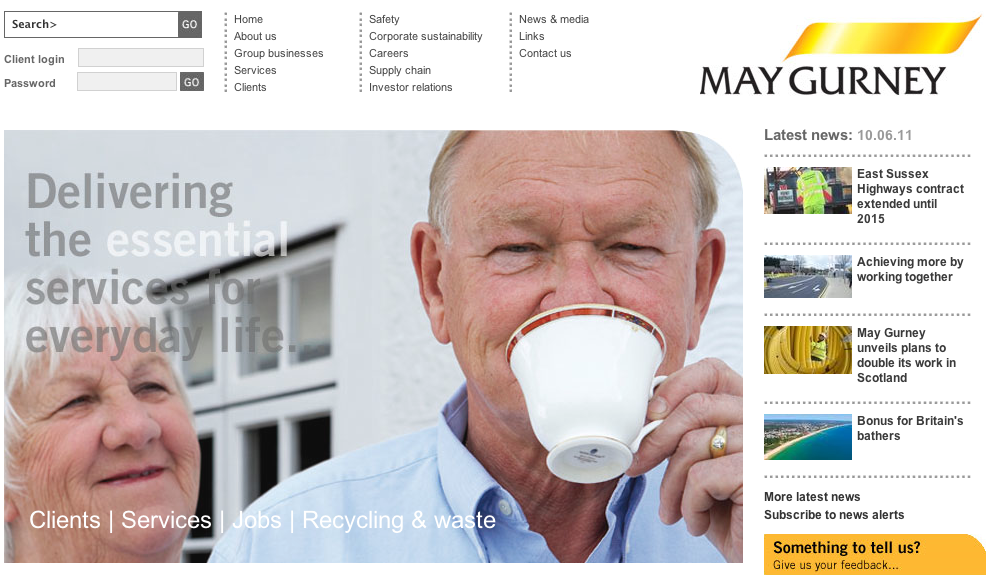When brands run wild
This screenshot is from the website of infrastructural services provider May Gurney. What do you think of it?
I’ve commented before on the tendency for all brands, in every sector, to become softer, funkier and less formal. In May Gurney’s case, we can see that this has taken the form of a focus on the furthest extreme of the value chain. May Gurney provides infrastructure support, which helps its clients to provide services, which make people happy.
So instead of showing exciting stuff like rubbish trucks, trains and butch roadmenders in luminous vests, the firm have chosen to give us some old bids drinking tea – happy people being the ultimate outcome of the services they provide.
Holes not drills
Of course, the philosophy behind this is well known to all marketers. People buy holes, not drills. Sizzle, not sausage. Benefits and outcomes rather than products and features.
The problem is that everything, ultimately, makes somebody happy. Cupcakes make people happy. So do iPods. Even my copywriting, if used correctly, makes some people happy.
If you inflate the benefit too much, or chase it too far up the value chain, you end up with a sort of branding reductio ad absurdum where everybody’s offering a generic, diffuse happiness benefit – and everybody’s looking much the same as a result. B2B services firms often suffer from this if they can’t easily depict what they do.
Mental images
But is it that they can’t show it, or that they won’t? Beneath the generic warm ‘n’ fuzzy stock imagery operates an actual, physical firm. Only May Gurney has its unique combination of people, sites, infrastructure and kit. Why not show them? They are the product. They are what clients actually pay for – even if they do so in the hope of a later or higher-order outcome.
At the end of the day, the client’s goals are their business. Could it, perhaps, even be a little patronising for a contractor to claim too much knowledge of, or empathy with, the client’s concerns? Might it be better to focus on your own knowledge, skills and heritage, instead of clambering up into the customer’s world the whole time?
I’m always telling my clients to show (or say) something real on their sites. To build a brand that reflects who they really are. But no-one listens – they all aspire to an aspirational brand, so it’s off down the picture library for a shot of a businesswoman holding a blue folder. And while that may feel edgy, it ultimately leads to a disconnection between brand and reality.
65% cotton 35% polyester
What do you think May Gurney are really like to deal with? Are they doe-eyed, sighing, ‘feminine’ social-worker types, wearing flowing skirts, ever concerned with the plight of the weak, old and infirm? Or could they, perhaps, be a bunch of gruff, no-nonsense blokes who wear ties with short-sleeved polyester-mix shirts that reveal beefy, coconut-mattinged forearms?
I exaggerate. But you see my point. If you drag your brand too far down Aspiration Street, you can end up with a message you don’t even believe in. And, more to the point, it might be one that your customers don’t even want to hear from you.
People are loved for who they are, not who they want to be. And brands, for better or worse, are just the same.
Comments (6)
Comments are closed.

Good stuff Tom. I blame all that new-fangled ‘branding’ bollocks.
I’d never heard of this company and when I looked at the picture against the white corporate-looking background I thought–well _there’s_ a rather industrial concept for an elder care facility.
Tom, infrastructure is complex. The words Heath and Robinson come to mind. So a bent picture with a straight headline or vice versa cuts through the clutter more than dump trucks, bridges and pvc pipes.
Most people lead humdrum lives. They dream of something better out of life. So ads pander to that dream.
So what am I banging on about? A straight headline with a bent picture would stand more chance of grabbing the reader’s eye. And holding it? Well that’s another story, which you speak eloquently about in earlier blogs.
This reminds me of that conundrum – if the universe is full of billions of stars all emitting light in every direction, why isn’t space infinitely bright? Similarly, if the world is full of companies all making us that bit happier, why aren’t we all walking around in a state of permanent ecstasy?
I agree 100% Tom. An ad or web page has to give me a good idea of what the company is all about in an instant. I want that information immediately and a pensioner enjoying a cup of cha just doesn’t do that…(unless the product is tea aimed at pensioners). If I’ve got to read a paragraph to find out what they are all about, it’s just not going to happen. The visuals and headline have to be a relevant hook and specific. Generic happiness doesn’t grab my attention, so click/look elsewhere.
Thanks, Tom. Another inspiring piece.